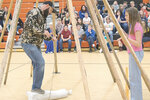Clear, 21° F
A tipi sat in the Powell Middle School gymnasium to be admired by all on Tuesday after Ty Fetter, a Buffalo Bill Center of the West maintenance tech, his daughter Addison, and two of her friends …
This item is available in full to subscribers.
The Powell Tribune has expanded its online content. To continue reading, you will need to either log in to your subscriber account, or purchase a subscription.
If you are a current print subscriber, you can set up a free web account by clicking here.
If you already have a web account, but need to reset it, you can do so by clicking here.
If you would like to purchase a subscription click here.
Please log in to continue |
|



A tipi sat in the Powell Middle School gymnasium to be admired by all on Tuesday after Ty Fetter, a Buffalo Bill Center of the West maintenance tech, his daughter Addison, and two of her friends built it within 20 minutes, using sandbags instead of stakes to preserve the gym floor.
The sixth grade class stared in awe from the bleachers and later, timidly entered the structure that was made using only a tripod, supporting beams and canvas, what in the frontier days would have been buffalo hide.
“Mr. Fetter, he told us a lot of stuff, about how three [poles] hold up better than four .. it was really interesting to learn and help set up,” said Teagan Gillett, a sixth grade student chosen to help with the construction.
The moment and the weeks-long lesson on American Indian history in Powell that preceded it were over 50 years in the making, Powell Middle social studies teacher Myra LaFrentz said. When she had the chance to do her long awaited lesson she chose to focus on the Crow tribe because they are a dominant tribe in the area.
“I decided what I would do is that I would create a program called Smoke Signals via the Airwaves,” LaFrentz said. “So we all did our presentations in first person as if we really, really, really were a Crow Indian in the middle of the 1800s.”
As a result of the lessons students learned to appreciate Native American culture, LaFrentz said.
“The Indians, they kind of just got kicked out and they lost all their ways and that was generations of … tradition,” Gillett said. “And so I kind of wish we hadn’t taken over all the way because then it still would have been maybe some more Indian culture.”
Students crafted clothes, tipis, cradle boards, lobbied to the “president” and created advertisements.
During the interactive activities students had to take into consideration that money did not exist in its current form, so they had to think of items in value of rabbit skins.
For students Maci MaGill, Gillett and Wade Gernhart, being able to learn through hands-on activities helped the learning process, they said. They began with a study guide based on LaFrentz’s power points before diving into the hands-on projects.
“She gave us stuff and she would show us how they would work and then we would get to use them,” MaGill said.
When the class tried on clothing loaned by the Buffalo Bill Center of the West they performed a welcoming dance around the classroom to the beat of drums also loaned by the museum. When the students had to conduct interviews in a “60 Minutes” style they became the historical figures they were asked to portray, LaFrentz said.
“I think that it really inspired them to learn. I think by doing everything in the first person, they immerse themselves into the culture,” LaFrentz said. “I don’t think it would have been nearly as effective if we had just read pages six through 10 or whatever and answered the questions.”